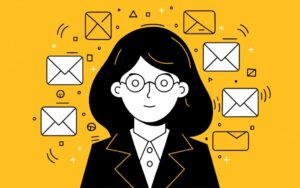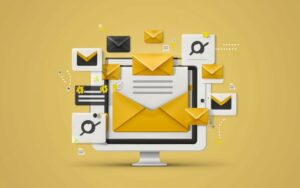Following up with prospects, clients, or colleagues through email is a critical skill in maintaining relationships and driving results. Here are 17 good practices to ensure your follow-up emails are effective and engaging:
1. Personalize Your Message
Tailor your email to the recipient by using their name and referencing previous interactions. Personalization shows you value the relationship and have taken the time to address their specific needs. Mentioning details from past conversations can also make your emails feel more personal and engaging. Additionally, addressing specific pain points or interests discussed previously can show that you were attentive and care about their concerns. Use data from your CRM to add relevant details that make your message stand out. Personalized emails are more likely to capture attention and generate positive responses.
2. Keep It Short and Sweet
Respect your recipient’s time by keeping your follow-up email concise. Focus on the key points and avoid unnecessary details. A well-structured, brief email is more likely to be read and responded to. Use short paragraphs and bullet points to break up the text and make it easier to digest. Start with a clear purpose and end with a straightforward call to action. Providing all necessary information in a concise format increases the likelihood of your email being acted upon.
3. Use a Clear Subject Line
A compelling and specific subject line can increase the chances of your email being opened. Make it clear what the email is about and why it’s important for the recipient to read it. Avoid vague or generic subject lines that don’t convey the purpose of your email. Experiment with different phrasing to see what resonates best with your audience. Including a sense of urgency or a question can also entice recipients to open your email. A well-crafted subject line sets the tone for the rest of your message.
4. Provide Context
Remind the recipient of your previous interaction or the reason for your follow-up. This helps them quickly understand the purpose of your email and the action you are requesting. Recap key points from your last conversation to jog their memory. Providing context shows that you are organized and considerate of their time. It also helps build a narrative, making your follow-up more relevant and engaging. Ensuring the recipient has all the necessary background information can lead to more productive responses.
5. Add Value
Offer additional information, resources, or insights that are beneficial to the recipient. This demonstrates your commitment to helping them and adds value to the conversation. Share relevant articles, case studies, ebooks or tools that address their specific needs or interests. Providing value in your follow-up emails can position you as a knowledgeable and helpful resource. This approach not only strengthens your relationship but also encourages the recipient to view you as a trusted advisor. Consistently adding value increases the likelihood of positive engagement.
6. Include a Call to Action
Clearly state what you want the recipient to do next. Whether it’s scheduling a meeting, providing feedback, or making a decision, a clear call to action can guide them to the desired outcome. Avoid vague requests and be specific about what you are asking for. Include deadlines if applicable to create a sense of urgency. Providing multiple ways to respond, such as through email, phone, or a link to a scheduling tool, can make it easier for the recipient to take action. A strong call to action is crucial for driving the next steps.
7. Be Polite and Professional
Maintain a courteous and professional tone in your follow-up emails. Politeness fosters positive relationships and shows respect for the recipient. Even if you are following up on an urgent matter, remain calm and respectful in your tone. Express appreciation for their time and consideration. Avoid using slang or overly casual language, which can undermine your professionalism. A polite and professional demeanor helps build trust and credibility.
8. Use Bullet Points
Break down complex information into bullet points for easy reading. This format helps recipients quickly grasp the main points and respond accordingly. Bullet points can make your email look more organized and less daunting to read. Use them to highlight key details, benefits, or action items. This approach can be particularly effective when summarizing lengthy discussions or outlining multiple steps. Structuring your email in a reader-friendly format can improve comprehension and response rates.
9. Timing Matters
Send your follow-up email at an appropriate time. Avoid weekends and late hours. Generally, mid-morning or early afternoon on weekdays are ideal times for follow-up emails. Consider the recipient’s time zone to ensure your email arrives at a convenient time. Timing can affect the likelihood of your email being opened and acted upon. Follow up promptly after initial interactions, but avoid being too aggressive. Strategic timing can enhance the effectiveness of your follow-up.
10. Follow Up Promptly
Don’t wait too long to send your follow-up email. A prompt follow-up shows your enthusiasm and commitment. Aim to follow up within a few days of your initial interaction. Timely follow-ups keep the conversation fresh in the recipient’s mind. Delaying your follow-up can lead to lost opportunities and decreased engagement. Consistent and timely follow-ups demonstrate reliability and professionalism.
11. Track Your Emails
Use email tracking tools to monitor open rates and engagement. This data can help you understand when and how recipients interact with your emails, allowing you to optimize future follow-ups. Tracking tools can provide insights into the best times to send emails and which subject lines are most effective. Use this information to refine your strategy and improve your results. Monitoring engagement can also help you identify which contacts require more attention. Data-driven decisions can enhance the effectiveness of your follow-up emails.
12. Segment Your Audience
Tailor your follow-up emails to different segments of your audience. By addressing the specific needs and interests of each segment, you can increase the relevance and effectiveness of your emails. Use data such as industry, job role, and past interactions to personalize your messages. Segmented follow-ups can lead to higher engagement rates and better responses. Creating targeted campaigns for different audience segments ensures that your message resonates with each group. This approach can significantly improve your email marketing results.
13. Avoid Generic Templates
While templates can save time, ensure that your follow-up emails do not feel generic. Customize templates to include personal touches and relevant information. Personalization can make your emails more engaging and effective. Avoid using cookie-cutter language that feels impersonal. Tailoring your templates to reflect the recipient’s unique situation can enhance the impact of your message. A personalized approach can differentiate you from competitors who rely on generic templates.
14. Test Different Approaches
Experiment with different email formats, subject lines, and calls to action. A/B testing can help you determine which approaches are most effective for your audience. Regularly testing and analyzing your emails can lead to continuous improvement. Pay attention to metrics such as open rates, click-through rates, and response rates. Use the insights gained from testing to refine your strategy. Continuous experimentation and optimization can enhance the effectiveness of your follow-up emails.
15. Provide a Recap
Summarize key points from previous conversations or meetings. This helps the recipient recall important details and provides a clear context for your follow-up. A concise recap can make your email more relevant and easier to understand. Highlighting main takeaways and next steps can facilitate decision-making. Providing a clear summary can also demonstrate your attentiveness and organizational skills. A well-structured recap can enhance the recipient’s understanding and response.
16. Express Gratitude
Thank the recipient for their time and consideration. Expressing gratitude can build goodwill and foster a positive response. A simple thank-you can go a long way in strengthening relationships. Acknowledge their effort in reading and responding to your email. Gratitude can make your follow-up more personable and respectful. Showing appreciation can enhance the recipient’s perception of you and your brand.
17. Be Persistent, Not Annoying
Follow up persistently, but don’t overwhelm the recipient with too many emails. Space out your follow-ups appropriately and pay attention to any cues that indicate whether to continue or stop. Persistence shows determination and interest, but excessive emails can be counterproductive. Respect the recipient’s time and boundaries. If you don’t receive a response after several attempts, consider alternative communication methods. Balancing persistence with respect can lead to more effective follow-up.
Case Study: The Impact of Personalization on Follow-Up Emails
Case Study: Boosting Response Rates with Personalization
Company: Tech Solutions, a B2B SaaS provider
Challenge: Tech Solutions faced low response rates for their follow-up emails after initial product demos. Prospects often ignored generic follow-ups, leading to missed sales opportunities.
Solution: The sales team decided to personalize their follow-up emails significantly. Instead of using generic templates, they incorporated specific details from the demos. Each email mentioned the prospect’s business challenges discussed during the demo and highlighted how Tech Solutions’ product could address those specific needs.
Implementation: The personalized follow-up emails included:
- The prospect’s name and company details.
- Specific pain points and solutions discussed.
- References to particular features of the product that would benefit the prospect.
- A tailored call to action, inviting the prospect to a further discussion or trial.
Outcome: Over a three-month period, Tech Solutions saw a 40% increase in response rates to their follow-up emails. Prospects appreciated the tailored approach, which showed that the sales team understood their unique challenges. This personalization not only increased engagement but also accelerated the sales cycle, resulting in a 25% increase in conversions.
Conclusion: This case study highlights the effectiveness of personalized follow-up emails. By taking the time to customize messages based on individual interactions, Tech Solutions significantly improved their engagement and conversion rates, demonstrating the power of personalization in email marketing.




